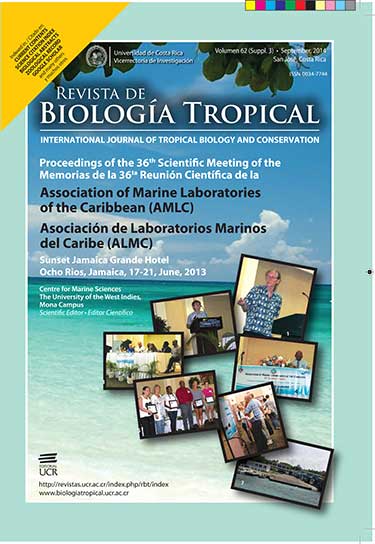Resumen
Los retos actuales para la sostenibilidad del arrecife de coral incluyen la sobrepesca, prácticas pesqueras destructivas, decoloración de corales, acidificación del océano, aumento del nivel del mar, brotes de estrellas de mar, floraciones algales, escorrentías agrícolas, el desarrollo costero y hotelero, contaminación, enfermedades, especies invasoras y huracanes. Utilizamos transectos de cinturón SCUBA para registrar la cobertura de coral y analizar imágenes digitales en el arrecife Dairy Bull, en la costa norte de Jamaica en el Caribe, y encontramos que constituye un ejemplo positivo de cómo los arrecifes pueden recuperarse después de una perturbación ambiental importante. La cobertura de coral vivo aumentó de 13±5% en 2006 a 31±7% en 2008, mientras que Acropora cervicornis aumentó de 2±2% en 2006 a 22±7% en 2008. Los niveles de cobertura de coral se mantuvieron hasta el 2012.Citas
Bruckner, A.W. (2012). Static measurements of the resilience of Caribbean coral populations. International Journal of Tropical Biology and Conservation, 60(suppl. 1), 39-57.
Crabbe, M. J. C. (2009). Scleractinian coral population size structures and growth rates indicate coral resilience on the fringing reefs of North Jamaica. Marine Environmental Research, 67, 189-198.
Crabbe, M. J. C. (2010). Topography and spatial arrangement of reef-building corals on the fringing reefs of North Jamaica may influence their response to disturbance from bleaching. Marine Environmental Research, 69, 158-162.
Crabbe, M. J. C., & Carlin, J. P. (2007). Industrial sedimentation lowers coral growth rates in a turbid lagoon environment, Discovery Bay, Jamaica. International Journal of Integrative Biology, 1, 37-40
Díaz-Pulido, G., McCook, L. J., Dove, S., Berkelmans, R., Roff, G., Kline, D. I., ... & Hoegh-Guldberg, O. (2009). Doom and boom on a resilient reef: climate change, algal overgrowth and coral recovery. PLoS One, 4(4), e5239.
Eakin C. M., Morgan, J. A., Heron, S. F., Smith, T. B., Liu, G., Alvarez-Filip, L., Baca, B., Bartels, E., Bastidas, C., … & Yusuf Y. (2010). CaribbeanCorals in Crisis: Record Thermal Stress, Bleaching, and Mortality in 2005. PLOSONE, 5(11), e13969. doi:10.1371/journal.pone.0013969
English, S., Wilkinson, C., & Baker, V. (1997). Survey Manual for Tropical Marine Resources, 2nd Edition. Townsville: Australian Institute of Marine Science.
Huston, M. (1985). Variation of coral growth rates with depth at Discovery Bay, Jamaica. Coral Reefs, 4, 19-25.
Idjadi, J. A., Lee, S. C., Bruno, J. F., Precht, W. F., Allen-Requa, L., & Edmunds, P. J. (2006). Rapid phase-shift reversal on a Jamaican coral reef. Coral Reefs, 25, 209-211.
Jones, L., Alcolado, P. M., Cala, Y., Cobián, D., Coelho, V., Hernández, A., Jones, R., Mallela, J., & Manfrino, C. (2008). The effects of coral bleaching in the northern Caribbean and western Atlantic, pp. 73-83. In Wilkinson, C., & Souter, D. (eds.). Status of Caribbean Coral Reefs after Bleaching and Hurricanes in 2005. Townsville, Australia: Global Coral Reef Monitoring Network, and Reef and Rainforest Research Centre.
Kinzig, A. P., & Pacala, S. W. (2001). Successional biodiversity and ecosystemfunctioning, pp. 175-212. In Kinzig, A.P., Pacala, S.W., & Tilman, D. (Eds.), The functional consequences of biodiversity. Princeton, USA: Princeton University Press.
Mallela, J., & Crabbe, M. J. C. (2009). Hurricanes and coral bleaching linked to changes in coral recruitment in Tobago. Marine Environmental Research, 68, 158-162.
Mumby, P. J., Hastings, A., & Edwards, H. J. (2007). Thresholds and the resilience of Caribbean coral reefs. Nature, 450, 98-101.
Quinn, N. J., & Kojis, B. L. (2008). The recent collapse of a rapid phase-shift reversal on a Jamaican north coast reef after the 2005 bleaching event. International Journal of Tropical Biology and Conservation, 56 (suppl. 1), 149-159.
Sary, Z., Oxenford, H. A., & Woodley, J. D. (1997). Effects of an increase in trap mesh size on an over-exploited coral reef fishery at Discovery Bay, Jamaica. MarineEcology Progress Series, 154,107-120.
Stat, M., Loh, W. K. W., Hoegh-Guldberg, O., & Carter, D. A. (2008). Symbiont acquisition strategy drives host-symbiont associations in the southern Great Barrier Reef. Coral Reefs, 27, 763-772.
##plugins.facebook.comentarios##

Esta obra está bajo una licencia internacional Creative Commons Atribución 4.0.
Derechos de autor 2014 Revista de Biología Tropical






